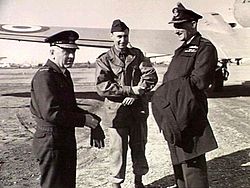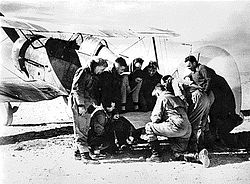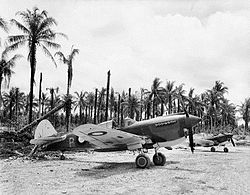- Gordon Steege
-
Gordon Henry Steege 
Flight Lieutenant Steege in North Africa, December 1940Born 31 October 1917
Chatswood, New South WalesAllegiance  Australia
AustraliaService/branch  Royal Australian Air Force
Royal Australian Air ForceYears of service 1937–1946
1950–1972Rank Air Commodore Unit No. 3 Squadron (1940–41) Commands held No. 450 Squadron (1941–42)
No. 73 Wing (1943–44)
No. 81 Wing (1944–45)
No. 77 Squadron (1951)
RAAF Base Canberra (1957–58)
RAAF Base Amberley (1964–67)
RAAF Base Butterworth (1967–70)Battles/wars - Middle East theatre
- North African campaign
- South West Pacific theatre
- New Britain campaign
- Battle of Arawe
- Admiralty Islands campaign
Awards Distinguished Service Order
Distinguished Flying Cross
Mentioned in DespatchesAir Commodore Gordon Henry Steege DSO, DFC (born 30 October 1917) is a retired senior officer of the Royal Australian Air Force (RAAF). He became a fighter ace in World War II, credited with eight aerial victories. Joining the RAAF in July 1937, Steege first saw action with No. 3 Squadron in the Middle East, where he was awarded the Distinguished Flying Cross after shooting down three German aircraft in a single sortie. He rose to command No. 450 Squadron in the Desert Air Force, before being posted to the South West Pacific, where he led Nos. 73 and 81 Wings. He earned the Distinguished Service Order for his "outstanding leadership", and finished the war a temporary Group Captain.
Resigning his commission following the end of World War II, Steege rejoined the RAAF during the Korean War, and briefly took command of No. 77 Squadron late in 1951. Returning to Australia, he held senior administrative and training posts in Canberra, before taking charge of RAAF Base Canberra in 1957. In the 1960s he was appointed to various planning positions, followed by command of RAAF Base Amberley, Queensland, and later RAAF Base Butterworth, Malaysia. Having been raised to Air Commodore, his final appointment before retiring in 1972 was on the staff of Headquarters Operational Command (now Air Command) at RAAF Base Glenbrook, New South Wales.
Contents
Early career
Born in the Sydney suburb of Chatswood on 31 October 1917, Gordon Steege was educated at North Sydney Boys High School.[1][2] He joined the Royal Australian Air Force (RAAF) on 21 July 1937, undergoing flight instruction at No. 1 Flying Training School, RAAF Station Point Cook, Victoria. Graduating as a Pilot Officer in June 1938, he was posted to No. 3 Squadron at RAAF Station Richmond, New South Wales, flying Hawker Demon fighters.[3][4] He was promoted to Flying Officer in December 1938. Following the outbreak of World War II in September 1939, he spent six months as an adjutant with the newly formed No. 11 Squadron, which operated the Short Type C.[2][5] He returned to No. 3 Squadron in May 1940, was promoted to Flight Lieutenant the following month, and shipped out to the Middle East with his unit on 15 July.[3][6][7]
World War II
Middle East
Piloting a Gloster Gladiator biplane, Steege scored his first aerial victory in the North African campaign when he shot down an Italian Fiat CR.42 on 10 December 1940; he also claimed a "probable" in the same action.[6][8] Three days later he shared in three more "kills", two CR.42s and a Savoia-Marchetti SM.79.[6] After No. 3 Squadron converted to Hawker Hurricanes, Steege shot down three Junkers Ju 87s in a single sortie near Mersa Matruh on 18 February 1941, to become his unit's second "ace". Following this exploit, and the destruction of a Messerschmitt Bf 110 on 3 April, he was awarded the Distinguished Flying Cross.[6][9] The recommendation noted his "unfailing courage", and the award was gazetted on 11 April.[10][11]
Raised to acting Squadron Leader, Steege was given command of the newly established No. 450 Squadron at Rayak, Lebanon, on 31 May 1941.[3][12] The assignment was a challenging one, as the operational requirements of existing forces, and the RAAF Air Board's insistence on staffing Article XV squadrons such as No. 450 with Australian Empire Air Training Scheme aircrew rather than Permanent Air Force members, meant that the unit was short of experienced pilots.[13] By December, however, the squadron was up to nominal strength and equipped with P-40 Kittyhawks; it began combat operations out of Gambut and El Adem, Libya, registering victories from February 1942.[14] Steege himself scored a confirmed victory over a Messerschmitt Bf 109 on 28 March.[15] He returned to Australia as a temporary Wing Commander later that year,[3][6] having been Mentioned in Despatches on 24 September 1941.[16] His final tally of victories was eight enemy aircraft destroyed,[6][15][17] two probables and five damaged.[15][17]
South West Pacific
Steege undertook courses and held commands at various Fighter Sector Headquarters in Australia during 1943, until being posted for action in the South West Pacific. That October, he assumed command of No. 73 Wing, consisting of two P-40 Kittyhawk squadrons and a Spitfire squadron operating out of Kiriwina, New Guinea.[3][18] As part of the build-up to the Battle of Arawe in December, the Kittyhawks launched a series of assaults on Gasmata; three days before the Allied landings, Steege personally led a force of thirty-four aircraft in a bombing and strafing attack on the town's landing strip.[19] In January 1944, the wing took part in the two largest raids mounted by the RAAF to that time, each involving over seventy aircraft attacking enemy camps and depots at Lindenhafen, New Britain.[20] Steege was promoted acting Group Captain the following month; the rank was made temporary in July.[3]
As part of the RAAF's contribution to the Admiralty Islands campaign, Steege led No. 73 Wing on garrison duty at Los Negros commencing in March 1944. The wing's combat squadrons—Nos. 76, 77 and 79—were supported by No. 49 Operational Base Unit, No. 114 Mobile Fighter Sector, No. 27 Air Stores Park and No. 26 Medical Clearing Station, among other ancillaries. The fighters’ main duty was providing cover for Allied shipping; they also carried out bomber escort, ground attack and anti-shipping missions.[21] In mid-April, the wing escorted the largest Allied convoy in the South-West Pacific to that date, 80 ships carrying 30,000 personnel, from Finschhafen to Aitape.[22] On 11 April, Steege was awarded the Distinguished Service Order for his "outstanding leadership".[6][23] Completing their garrison work in the Admiralties that June, No. 73 Wing's Kittyhawk units were transferred during August–September to No. 81 Wing on Noemfoor under Steege's command, becoming part of No. 10 Operational Group (renamed the Australian First Tactical Air Force in October 1944).[24] In January 1945, Steege was appointed Senior Air Staff Officer (SASO) at Eastern Area Command, Sydney, before posting to RAAF Headquarters, Melbourne, in May.[3][6] During June–December, he attended the Army and Navy Staff College in Washington, D.C.[2]
Korean War and after
 Wing Commander Steege (centre) with Air Vice Marshal John McCauley (left) and Group Captain A.G. Carr (right) in South Korea, November 1951
Wing Commander Steege (centre) with Air Vice Marshal John McCauley (left) and Group Captain A.G. Carr (right) in South Korea, November 1951
Steege married Joan Tait on 5 January 1946; they had a son and a daughter. In February he was appointed RAAF Director of Operations.[2] Steege resigned from the Air Force in December 1946, joining the New Guinea Administration as a patrol officer the next month. He rejoined the Air Force as a Wing Commander during the Korean War, taking charge of RAAF Station Schofields in September 1950, before commencing jet training in March the following year.[3][6] On 16 August 1951, he was posted to Kimpo, South Korea, as commander of No. 77 Squadron, shortly after its conversion from P-51 Mustangs to Gloster Meteors. One of his first actions, following discussions with the US Fifth Air Force, was to take the Australian unit out of its then-current air-to-air combat role, and curtail its operations in "MiG Alley". Two encounters between No. 77 Squadron and Chinese MiG-15s had convinced Steege that the straight-winged Meteors were outclassed as fighters by the swept-wing MiGs. His decision caused controversy as some Allied commanders believed that proper training and tactics would have allowed the Meteor to remain competitive as a fighter, while for the Australian pilots the change of role amounted to a loss of prestige.[25][26] However Steege was backed up by the Chief of the Air Staff, Air Marshal George Jones, and the squadron was relegated mainly to escort duty and local air defence. Morale suffered and it was not until after Steege's departure on 26 December that a suitable offensive role was again found for the Meteors, namely ground attack.[25][27]
After returning to Australia, Steege held senior appointments at the School of Land/Air Warfare from February 1952, the Department of Air in Canberra from August that year, and Headquarters Training Command commencing in August 1955. In May 1957 he took command of RAAF Base Canberra, Australian Capital Territory. He was promoted to acting Group Captain in May 1958 (substantive two months later), before becoming Senior Planner at the SEATO Military Planning Office, Bangkok, in December 1958. Steege returned to the Department of Air in December 1961, where he rose to Director of Plans. Promoted to Air Commodore, he was appointed Officer Commanding (OC) RAAF Base Amberley, Queensland, in November 1964, and OC RAAF Base Butterworth, Malaysia, in May 1967. He then served as Senior Air Staff Officer at Headquarters Operational Command (now Air Command) in RAAF Base Glenbrook, New South Wales, from May 1970 until retiring from the Air Force on 31 October 1972.[3][6] In retirement Steege maintained his connection with No. 450 Squadron through its association of former members; as a guest at the 1994 RAAF History Conference in Canberra he spoke at length on the difficulties of establishing the unit in the Middle East in 1941.[28] In 2010, he joined three of his fellow members of No. 3 Squadron who shipped out to the Middle East on 15 July 1940 for the 70th anniversary commemoration of the event at RAAF Base Richmond.[29]
Notes
- ^ Steege, Gordon Henry at World War 2 Nominal Roll. Retrieved on 26 November 2010.
- ^ a b c d Chisholm, Who's Who in Australia 1947, p.780
- ^ a b c d e f g h i Air Commodore Gordon Henry Steege at Australian War Memorial. Retrieved on 26 November 2010.
- ^ Roylance, Air Base Richmond, p.123
- ^ Roylance, Air Base Richmond, p.125
- ^ a b c d e f g h i j Garrisson, Australian Fighter Aces, p.160
- ^ 3 Squadron RAAF at Australian War Memorial. Retrieved on 28 November 2010.
- ^ Thomas, Gloster Gladiator Aces, p.44
- ^ Thomas, Hurricane Aces 1941–45, p.49
- ^ Recommendation: Distinguished Flying Cross at Australian War Memorial. Retrieved on 26 November 2010.
- ^ London Gazette: (Supplement) no. 35131. p. 2041. 8 April 1941. Retrieved on 26 November 2010.
- ^ Herington, Air War Against Germany and Italy, p.95
- ^ Herington, Air War Against Germany and Italy, pp.96–99
- ^ Herington, Air War Against Germany and Italy, p.218
- ^ a b c Newton, Australian Air Aces, p.110
- ^ London Gazette: (Supplement) no. 35284. pp. 5569–5573. 24 September 1941. Retrieved on 26 November 2010.
- ^ a b Thomas, Hurricane Aces 1941–45, p.88
- ^ Odgers, Air War Against Japan, p.69
- ^ Odgers, Air War Against Japan, p.126
- ^ Odgers, Air War Against Japan, pp. 130–131
- ^ Odgers, Air War Against Japan, pp. 170–177
- ^ Odgers, Air War Against Japan, p. 209
- ^ London Gazette: (Supplement) no. 36463. p. 1674. 11 April 1944. Retrieved on 26 November 2010.
- ^ Odgers, Air War Against Japan, p. 249
- ^ a b Stephens, The Royal Australian Air Force, pp.236–237
- ^ O'Neill, Combat Operations, p.358
- ^ Wilson, The Brotherhood of Airmen, pp.181–182
- ^ Mordike, The RAAF in Europe and North Africa 1939–1945, pp.14–16,61
- ^ 70th Anniversary of 3 Squadron "Marching Out" to War at 3 Squadron RAAF Association. Retrieved on 28 November 2010.
References
- Chisholm, Alec H. (ed.) (1947). Who's Who in Australia 1947. Melbourne: The Herald and Weekly Times.
- Garrisson, A.D. (1999). Australian Fighter Aces 1914–1953. Fairbairn, Australian Capital Territory: Air Power Studies Centre. ISBN 0642265402. http://airpower.airforce.gov.au/Publications/Details/220/Australian-Fighter-Aces-1914–1953.aspx.
- Herington, John (1954). Australia in the War of 1939–1945: Series Three (Air) Volume III – Air War Against Germany and Italy 1939–1943. Canberra: Australian War Memorial. http://www.awm.gov.au/histories/chapter.asp?volume=28.
- Mordike, John (ed.) (20 October 1994). "The RAAF in Europe and North Africa 1939–1945: The Proceedings of the 1994 RAAF History Conference". Canberra: RAAF Air Power Studies Centre. ISBN 0642224757. http://airpower.airforce.gov.au/Publications/Details/201/RAAF-History-Conference-1994-The-RAAF-in-Europe-and-North-Africa-19391945.aspx.
- Newton, Dennis (1996). Australian Air Aces. Fyshwyck, Australian Capital Territory: Aerospace Publications. ISBN 1875671250.
- Odgers, George (1968) [1957]. Australia in the War of 1939–1945: Series Three (Air) Volume II – Air War Against Japan 1943–45. Canberra: Australian War Memorial. http://www.awm.gov.au/histories/chapter.asp?volume=27.
- O'Neill, Robert (1985). Australia in the Korean War 1950–53: Volume 2 – Combat Operations. Canberra: Australian War Memorial & Australian Government Publishing Service. ISBN 0642043302.
- Roylance, Derek (1991). Air Base Richmond. RAAF Base Richmond: Royal Australian Air Force. ISBN 0646052128.
- Stephens, Alan (2006) [2001]. The Royal Australian Air Force: A History. London: Oxford University Press. ISBN 0195555414.
- Thomas, Andrew (2002). Gloster Gladiator Aces. Oxford: Osprey. ISBN 9781841762890.
- Thomas, Andrew (2003). Hurricane Aces 1941–45. Oxford: Osprey. ISBN 9781841766102.
- Wilson, David (2005). The Brotherhood of Airmen. Crows Nest, New South Wales: Allen & Unwin. ISBN 1741143330.
Categories:- 1917 births
- Australian aviators
- Australian military personnel of the Korean War
- Australian World War II flying aces
- Companions of the Distinguished Service Order
- Living people
- People from Sydney
- Recipients of the Distinguished Flying Cross (United Kingdom)
- Royal Australian Air Force officers
Wikimedia Foundation. 2010.


